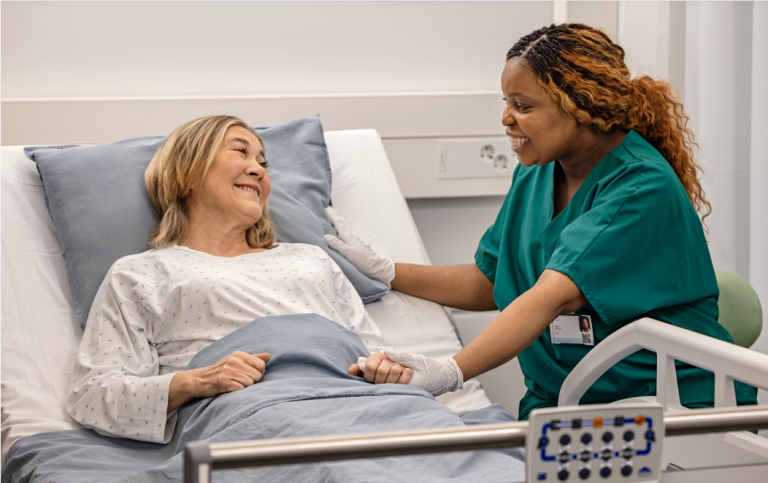
As the healthcare industry continues emerging from the COVID-19 pandemic, it has become clear that hospitals investing in flexibility will be well-positioned to thrive in the new era of healthcare.
The healthcare system nearly broke under the weight of the last three years: COVID-19, rising costs of care and labor, as well as workforce shortages. While healthcare institutions have responded to these challenges with heroic efforts, many healthcare leaders are recognizing that it’s time to make more long-term changes to continue to adapt and build a level of flexibility that is both effective and sustainable.
Flexible healthcare is the innovative ability and organizational alignment to rapidly adapt care delivery in the face of critical change.
“Adaptability and flexibility are key considerations that hospital leaders are talking about right now,” said Julie Viola, founder and chief strategist, Cody Health Ventures. “Hospitals have to adapt their care delivery models.”
Executives interviewed for this series of articles explained that the consequences of inaction are immediate. Lack of flexibility can lead to lost inpatient revenue due to capacity issues, lost ambulatory revenue due to access challenges, increased length of stay and cost of care, overloaded EDs, exacerbated clinician burnout – all of which result in poorer patient outcomes.
In addition to improving general operations and patient care, increasing flexibility will enable hospitals and health systems to optimize workloads, reduce burnout, and leverage virtual care to ultimately remain or return to financial sustainability.
“The focus on patient flow is growing astronomically because we have to treat more patients. We do not have beds to give right now. Virtual and longitudinal care are going to increase with the scarcity of resources because of the ability to see more patients quickly.” — CIO, West Coast academic medical center
So what exactly does a more flexible healthcare system look like? In this first article of our four-part series, we will highlight three approaches that are gaining traction and interest among our hospital partners:
- Revisiting acuity adaptable units
- Expanding continuous monitoring capabilities
- Scaling longitudinal care models
Revisiting Acuity Adaptable Units
These care models advance the patient experience by bringing equipment, staff and resources to the patient depending on changing acuity levels, rather than moving the patient to different departments within the hospital. The concept was coined in the mid-1990s[1]. By the late 2000s, evidence-based proof points emerged[2]. Then in the years immediately prior to the pandemic, acuity adaptable rooms were considered “a new and better way for hospitals to design their care,[3]” according to the architecture firm Maugel DeStefano. Enabling this manner of flexibility requires significant modifications to hospital infrastructure, technology, workflows, and staffing (which is likely why the concept hasn’t gained widespread traction, yet).
While the concept has not become commonplace yet, today’s healthcare leaders are looking again at acuity adaptable care and finding that the approach brings a number of advantages. In addition to helping in surge-like situations, Maugel DeStefano Architects noted that benefits include more efficient care delivery that results from fewer transfers and less room turnover overall, reduced burnout among clinicians and staff due to workload optimization, and the ability to optimize personnel and resources with virtual care, telehealth, and telenursing.
Expanding Continuous Monitoring Capabilities
Monitoring technologies, of course, are central to hospitals’ ability to be more flexible by enabling quicker response to changing care needs. Research shows that continuous monitoring of pulse oximetry, for example, significantly reduces transfers to the ICU and rescue events[4] and decreases length-of-stay and cardiac arrest incidents[5].
Complicating matters is that telemetry is highly overused for non-cardiac patients who need to be monitored but don’t have an ECG condition, which inhibits throughput, raises alarm fatigue, and can lead to patient harm[6]. Achieving greater flexibility requires wireless and wearable monitoring technologies that promote ambulation without the risk of tripping. In one study, enabling a 50% increase in patients’ step-count led to a 6% shorter length of stay[7], while another found that improving walkability reduced hospital admissions by 2.2 days[8]. The bottom-line benefit to continuously monitoring patients in the ward, as opposed to spot-checking vital signs every 2 or 4 hours, is the combination of cost-savings and substantial return on investment[9].
“What if we could buy a monitor that works in all our care settings? That flexibility would bring a lot of benefits.”— CIO, Midwest academic medical center
To achieve such results, in addition to modern monitoring technologies, hospitals also need to implement more robust infrastructure than the Wi-fi or Bluetooth connectivity widely used today. Instead, they need “medical grade” technologies suitable for intensive requirements of the hospital environments, including security protocols.
Scaling Longitudinal Care Models
Earlier this year, the American Medical Association outlined the synchronous and asynchronous components necessary for adequate virtual care[10]: “real-time audio-video visits, store-and-forward technologies, check-in services, inter-professional virtual consultations and remote patient monitoring.”
Today’s most innovative continuous monitoring devices are wireless and mobile, creating considerable potential for hospitals to extend care and monitoring outside their physical facilities. Research suggests that 75% of people over 50 years of age want to stay in their homes when receiving care[11]. Extending care into the home has also demonstrated improved outcomes with 50% fewer readmissions[12] and a 20% reduction in mortality[13].
During the pandemic, acute care — including telehealth and video consults, home visits, daily living assistance and home-based primary care — moved broadly beyond inpatient facilities[14] because of reimbursement changes that enabled reimbursement for virtual primary care. Health-at-home models thrive when data is flowing from various settings back to clinicians. Virtual models are demonstrating three key advantages over brick-and-mortar facilities: an ability to expand bed capacity and improve patient satisfaction and outcomes, at lower costs for patients and providers. [15]
What’s Needed Now? Strategic Flexibility
Taken together, acuity adaptable units, continuous monitoring beyond telemetry and the ICU, and longitudinal care present significant opportunities to improve health outcomes, operational efficiencies, patient safety, and staff and clinician satisfaction. These three examples for how health systems are proving their adeptness in flexible care can also help hospitals address another significant and pressing challenge: rising patient acuity levels overall.
In fact, in a recent survey of 100 hospital executives, 67% said that Americans are less healthy now than before the pandemic[16]. When asked specifically about the impact of pandemic-induced care delays, the respondents ranked rising acuity levels as the top issue to emerge from delayed care, followed by advanced disease presentation, a rise in the number of chronic care patients, an increase in ED patients and hospitalizations that overloads the healthcare system, and higher rates of mortality.
Meeting those issues with innovative tools for flexibility will enable hospital executives to lead initiatives that advance acuity adaptability, continuous monitoring beyond the ward, and longitudinal care that continues post-discharge.
To inform those strategies, the next articles in this series focus on:
- Part 2: Expanding Continuous Monitoring
- Part 3: Building Blocks of Acuity Adaptable Healthcare
- Part 4: Top Benefits and Common Challenges of Increasing Care Flexibility
References:
[1] HCD Guest Author (2008). Rethinking acuity adaptability, Healthcare Design Magazine: https://healthcaredesignmagazine.com/architecture/rethinking-acuity-adaptability/
[2] Zimring, C., & Seo, H. B. (2012). Making acuity-adaptable units work: lessons from the field. HERD, 5(3), 115–128. https://doi.org/10.1177/193758671200500311
[3] Maugel Architects (2019). Acuity Adaptable Rooms: What They Are and Why Hospital Needs Them. Maugel DeStephano Architects. https://www.maugel.com/blog/acuity-adaptable-rooms-what-they-are-and-why-hospitals-need-them
[4] GE HealthCare (2020). The Clinical Benefits of Continuous Monitoring of Wards Patients. Clinical View.https://clinicalview.gehealthcare.com/article/clinical-benefits-continuous-monitoring-ward-patients
[5]Brown, H., Terrence, J., Vasquez, P., Bates, D. W., & Zimlichman, E. (2013). Continuous monitoring in an inpatient medical-surgical unit: A controlled clinical trial. The American Journal of Medicine, 127(3), 226–232. https://doi.org/10.1016/j.amjmed.2013.12.004
[6] Winamer, Neil H., MD, SFHM (2023). Reducing Telemetry Overuse with Clinical Decision Support. NEJM Journal Watch. https://www.jwatch.org/na55888/2023/03/09/reducing-telemetry-overuse-with-clinical-decision-support
[7] McCullagh, R., Dillon, C., Dahly, D., Horgan, N. F., & Timmons, S. (2016). Walking in hospital is associated with a shorter length of stay in older medical inpatients. Physiological measurement, 37(10), 1872–1884. https://doi.org/10.1088/0967-3334/37/10/1872
[8] Health and social care services research (2019). Getting hospital patients up and moving shortens stay and improves fitness. National Institute for Health and Care Research (NIHR). doi: 10.3310/signal-000759
[9] Slight, S. P., Franz, C., Olugbile, M., Brown, H. V., Bates, D. W., & Zimlichman, E. (2014). The return on investment of implementing a continuous monitoring system in general medical-surgical units. Critical care medicine, 42(8), 1862–1868. https://doi.org/10.1097/CCM.0000000000000340
[10] AMA (2023) AMA telehealth quick guide. AMA. https://www.ama-assn.org/practice-management/digital/ama-telehealth-quick-guide
[11] AARP (2021) In-Home Care: Helping Loved Ones Age in Place. AARP. https://www.aarp.org/caregiving/home-care/info-2019/providing-homecare.html
[12] AAHCM. What is Home-Based Primary Care. American Academy of Home Care Medicine (AAHCM)
[13] AHA (2020). Creating Value By Bringing Hospital Care Home. American Hospital Association (AHA).https://www.aha.org/issue-brief/2020-12-03-value-initiative-issue-brief-creating-value-bringing-hospital-care-home
[14] NEJM (2023). Advancing the Future of “Care Without an Address”: From Recommendations from International Health Care Leaders. NEJM Catalyst. https://catalyst.nejm.org/doi/full/10.1056/CAT.23.0079
[15] Boldt-Crhistmas, O., Kannourakis, R., Maud, M. and Ungerman, D.(2023). Virtual hospitals could offer respite to overwhelmed health systems. McKinsey & Company. https://www.mckinsey.com/industries/healthcare/our-insights/virtual-hospitals-could-offer-respite-to-overwhelmed-health-systems
[16] Sage Growth Partners (2022). Hospitals Are Being Tested. Is The Healthcare C-Suite Ready? Sage Growth Partners. https://sage-growth.com/index.php/2022/11/americas-healthcare-crisis-market-report/







